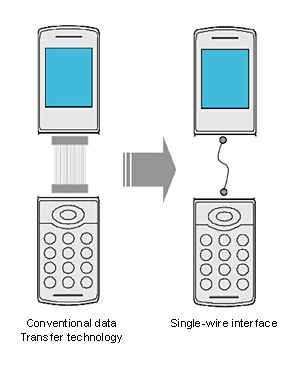Sony creates new wiring tech for twisting phones

Sony has developed a technology that allows both data and power transmissions through a single cable, potentially making it easier to build mobile devices with hinges or rotating parts.
The single-wire interface technology, announced on Friday, makes it possible to use one wire rather than dozens of wires when connecting a handset display to the body of a device. The technique allows the bi-directional transmission — at almost a gigabit per second — of video, audio and control signals through the same cable that powers the display.

The technology allows the bi-directional transmission through the same cable that powers the display. Credit: Sony
"In recent years, mobile devices have become ever more sophisticated in terms of advanced functionality and high-resolution displays," Sony said in a statement. "As a result, more wiring connections have been used to accommodate the increasing volume of data being transmitted within devices. Accordingly, new problems began to emerge as connectors in devices became larger and it became more difficult to bend the connecting cables.
"Sony aims to promptly implement this technology to improve design flexibility, reliability and durability for mobile devices with movable mechanisms," the company added.
The system uses what Sony says is a unique time-division duplex (TDD) and multiplex method, with the bi-directional aspect of the technology being based on a mechanism that retains the individual synchronisation of display and camera signals, to take two examples.
Sony's demonstration system, which can reach a transmission speed of 940Mbps, has three main elements: a digital portion that performs multilevel encoding, an analogue portion to transmit and receive the signals, and a portion to combine signals with or separate signals from DC power.
The company has teamed up with the Japanese component supplier Rohm to jointly develop the analogue portion of a test chip. Once this has been done, Sony said, it will give Rohm a licence for the intellectual property associated with the digital portion, so the two companies can create a single chip that incorporates all the portions of the single-wire interface technology system.
Sony's demonstration system has a digital portion, an analogue portion and a portion to combine signals with or separate signals from DC power. Credit: Sony